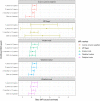Age-specific effects of childhood body mass index on multiple sclerosis risk
- PMID: 35532785
- PMCID: PMC9363310
- DOI: 10.1007/s00415-022-11161-4
Age-specific effects of childhood body mass index on multiple sclerosis risk
Abstract
Objective: Higher body mass index (BMI) during early life is thought to be a causal risk factor for multiple sclerosis (MS). We used longitudinal Mendelian randomisation (MR) to determine whether there is a critical window during which BMI influences MS risk.
Methods: Summary statistics for childhood BMI (n ~ 28,000 children) and for MS susceptibility were obtained from recent large genome-wide association studies (GWAS) (n = 14,802 MS, 26,703 controls). We generated exposure instruments for BMI during four non-overlapping age epochs (< 3 months, 3 months-1.5 years, 2-5 years, and 7-8 years) and performed MR using the inverse variance weighted method with standard sensitivity analyses. Multivariable MR was used to account for effects mediated via later-life BMI.
Results: For all age epochs other than birth, genetically determined higher BMI was associated with an increased liability to MS: Birth [Odds Ratio (OR) 0.81, 95% Confidence Interval (CI) 0.50-1.31, Number of Single-Nucleotide Polymorphisms (NSNPs) = 7, p = 0.39], Infancy (OR 1.18, 95% CI 1.04-1.33, NSNPs = 18, p = 0.01), Early childhood (OR 1.31, 95% CI 1.03-1.66, NSNPs = 4, p = 0.03), Later childhood (OR 1.34, 95% CI 1.08-1.66, NSNPs = 4, p = 0.01). Multivariable MR suggested that these effects may be mediated by effects on adult BMI.
Conclusion: We provide evidence using MR that genetically determined higher BMI during early life is associated with increased MS risk. This effect may be driven by shared genetic architecture with later-life BMI.
Keywords: Body mass index; Causation; Epidemiology; Mendelian randomization; Multiple sclerosis.
© 2022. The Author(s).
Conflict of interest statement
The authors have no relevant conflicts of interest or disclosures.
Figures

Similar articles
-
Childhood obesity and multiple sclerosis: A Mendelian randomization study.Mult Scler. 2021 Dec;27(14):2150-2158. doi: 10.1177/13524585211001781. Epub 2021 Mar 22. Mult Scler. 2021. PMID: 33749377
-
Effect of age at puberty on risk of multiple sclerosis: A mendelian randomization study.Neurology. 2019 Apr 16;92(16):e1803-e1810. doi: 10.1212/WNL.0000000000007325. Epub 2019 Mar 20. Neurology. 2019. PMID: 30894442 Free PMC article.
-
Obesity and Multiple Sclerosis: A Mendelian Randomization Study.PLoS Med. 2016 Jun 28;13(6):e1002053. doi: 10.1371/journal.pmed.1002053. eCollection 2016 Jun. PLoS Med. 2016. PMID: 27351487 Free PMC article.
-
Childhood, adolescent, and adulthood adiposity are associated with risk of PCOS: a Mendelian randomization study with meta-analysis.Hum Reprod. 2023 Jun 1;38(6):1168-1182. doi: 10.1093/humrep/dead053. Hum Reprod. 2023. PMID: 37015099 Free PMC article.
-
Environmental factors and risk of multiple sclerosis: Findings from meta-analyses and Mendelian randomization studies.Mult Scler. 2020 Apr;26(4):397-404. doi: 10.1177/1352458519872664. Epub 2019 Sep 6. Mult Scler. 2020. PMID: 32249718 Review.
Cited by
-
Ischemic Stroke and Cerebral Microbleeds: A Two-Sample Bidirectional Mendelian Randomization Study.Neurol Ther. 2023 Aug;12(4):1299-1308. doi: 10.1007/s40120-023-00500-w. Epub 2023 Jun 3. Neurol Ther. 2023. PMID: 37270442 Free PMC article.
-
Methodological approaches, challenges, and opportunities in the application of Mendelian randomisation to lifecourse epidemiology: A systematic literature review.Eur J Epidemiol. 2024 May;39(5):501-520. doi: 10.1007/s10654-023-01032-1. Epub 2023 Nov 8. Eur J Epidemiol. 2024. PMID: 37938447 Free PMC article.
-
A causal relationship between leukocyte telomere length and multiple sclerosis: A Mendelian randomization study.Front Immunol. 2022 Jul 15;13:922922. doi: 10.3389/fimmu.2022.922922. eCollection 2022. Front Immunol. 2022. PMID: 35911771 Free PMC article.
-
Modifiable risk factors for multiple sclerosis have consistent directions of effect across diverse ethnic backgrounds: a nested case-control study in an English population-based cohort.J Neurol. 2024 Jan;271(1):241-253. doi: 10.1007/s00415-023-11971-0. Epub 2023 Sep 7. J Neurol. 2024. PMID: 37676298 Free PMC article.
-
Determining the stability of genome-wide factors in BMI between ages 40 to 69 years.PLoS Genet. 2022 Aug 11;18(8):e1010303. doi: 10.1371/journal.pgen.1010303. eCollection 2022 Aug. PLoS Genet. 2022. PMID: 35951648 Free PMC article.
References
MeSH terms
Grants and funding
LinkOut - more resources
Full Text Sources
Medical

